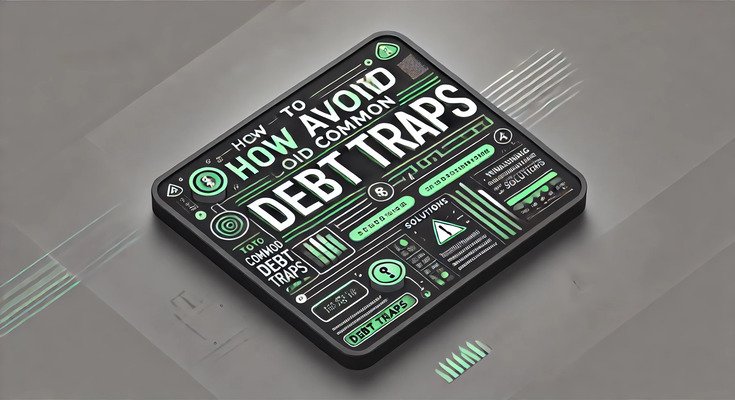How to Avoid Common Debt Traps: A Guide to Financial Freedom

Avoid Common Debt Traps: Smart Strategies for Financial Freedom[to Avoid Common Debt Traps]
Debt traps can severely impact financial stability, leading to stress and long-term repayment struggles. Whether it’s overspending on credit cards, taking out high-interest loans, or failing to save for emergencies, these financial habits can quickly spiral into unmanageable debt. This article explores practical strategies to avoid common debt traps, helping Indian consumers take control of their financial future.
What Are Debt Traps?[how to Avoid Common Debt Traps]
A debt trap occurs when an individual borrows money without a clear repayment strategy, leading to increasing debt over time. High interest rates and frequent borrowing can eat into your income, making it difficult to break free.
Common Examples of Debt Traps
- Credit Card Debt: Unpaid balances attract high interest charges.
- Payday Loans: Short-term loans with exorbitant interest rates.
- Multiple EMIs: Overcommitting to loan EMIs without proper financial planning.
- Borrowing to Repay Debt: Taking new loans to pay off existing ones, increases financial burden.
Why Debt Traps Are Common in India[importance to Avoid Common Debt Traps]
Understanding why people fall into debt traps can help in avoiding them. Some key reasons include:
- Easy Credit Access: The availability of credit cards, personal loans, and Buy Now Pay Later (BNPL) schemes makes borrowing simple.
- Low Financial Awareness: Many borrowers do not fully understand loan terms or interest rates.
- Cultural Pressures: Big-ticket expenses like weddings, festivals, and gifts often lead to unplanned borrowing.
- Lack of Emergency Funds: Without savings, individuals are forced to rely on loans during financial crises.
How to Avoid Common Debt Traps
1. Create a Realistic Budget
A budget helps in tracking income and expenses, ensuring you don’t overspend.
Example:
Ravi, who earns ₹50,000 per month, allocates his income wisely:
- 50% for essentials (rent, food, utilities)
- 30% for savings and investments
- 20% for lifestyle expenses
Tips:
- Use budgeting apps like Walnut or MoneyView.
- Regularly review and adjust your budget to stay on track.
2. Build an Emergency Fund
An emergency fund prevents the need for borrowing during unexpected situations.
Example:
Priya started saving ₹5,000 per month in a liquid mutual fund. In a year, she accumulated ₹60,000, covering three months’ expenses.
Action Plan:
- Start saving small amounts consistently.
- Keep funds in a liquid savings account or a low-risk investment.
3. Pay More Than the Minimum on Credit Cards[to Avoid Common Debt Traps]
Paying only the minimum due on credit cards can lead to excessive interest charges.
Impact of Minimum Payment:
If you owe ₹50,000 on a credit card with a 24% annual interest rate and only pay ₹2,500 per month, it could take years to clear the balance, with high-interest costs.
Solution:
- Pay your full balance every month.
- If full payment isn’t possible, try to pay more than the minimum.
4. Limit EMI Commitments[to Avoid Common Debt Traps]
Multiple loans can overburden your finances.
Example:
Anjali used 70% of her income for EMIs on a car loan, personal loan, and credit card debt. When a medical emergency arose, she struggled to meet payments.
Rule of Thumb:
Keep total EMI obligations below 40% of your monthly income.
5. Avoid High-Interest Loans[to Avoid Common Debt Traps]
Loans with high interest rates, like payday loans and instant personal loans, can quickly trap borrowers in debt.
Better Alternatives:
- Borrow from trusted sources like family or friends.
- Opt for secured loans, such as gold loans, which have lower interest rates.
6. Think Before Taking a Loan[to Avoid Common Debt Traps]
Before borrowing, assess whether the expense is essential.
Questions to Ask:
- Is this loan necessary?
- Can I afford the monthly repayments?
- Are there lower-cost alternatives available?
7. Be Cautious with BNPL Schemes
Buy Now Pay Later (BNPL) options seem convenient but can lead to excessive spending.
Example:
Raj used BNPL to buy a smartphone worth ₹60,000. Missing a payment resulted in high penalties and a damaged credit score.
Tips:
- Use BNPL only for planned purchases.
- Read all terms and conditions before opting for such schemes.
8. Increase Financial Literacy
Understanding financial concepts helps in making informed decisions.
Action Plan:
- Attend workshops or take online courses on financial planning.
- Follow trusted financial blogs like RichPath.in for expert insights.
9. Prioritize Debt Repayment
A structured debt repayment strategy can help you clear outstanding balances efficiently.
Debt Repayment Strategies:
- Avalanche Method: Pay off the highest-interest debt first.
- Snowball Method: Pay off the smallest debt first to build momentum.
Example:
Sneha had three loans:
- ₹50,000 at 24% interest
- ₹20,000 at 18% interest
- ₹10,000 at 12% interest
She focused on clearing the ₹50,000 loan first, saving money on interest in the long run.
10. Monitor Your Credit Score
A good credit score ensures lower interest rates and better loan terms.
How to Improve Your Score:
- Pay all dues on time.
- Keep credit utilization below 30%.
- Avoid frequent loan applications.
Where to Check Your Credit Score:
- Platforms like CIBIL or Experian offer free credit score checks.
How to Escape a Debt Trap
If you’re already caught in a debt trap, take immediate action:
1. Stop Accumulating Debt
- Avoid taking new loans or using credit cards until your financial situation stabilizes.
2. Negotiate with Creditors
- Contact your bank to request a lower interest rate or an extended repayment period.
3. Consolidate Your Debt
- Consider taking a personal loan with a lower interest rate to pay off high-interest debts.
Example:
Manish had ₹5 lakh in credit card debt. He took a low-interest personal loan and repaid the debt over three years, saving significantly on interest.
4. Seek Professional Help
- Consult a financial advisor or credit counselor for a structured debt repayment plan.
Long-Term Benefits of Avoiding Debt Traps
- Financial Stability: More savings and fewer financial emergencies.
- Lower Stress: Freedom from constant repayment worries.
- Improved Creditworthiness: Better loan offers with lower interest rates.
- Wealth Creation: Extra funds can be invested for long-term growth.
Conclusion
To avoid common debt traps, you need discipline, financial literacy, and smart planning. By creating a budget, building an emergency fund, avoiding high-interest loans, and focusing on debt repayment, you can maintain financial stability and achieve long-term financial freedom.
The key to a secure financial future is living within your means and making informed financial decisions.
For expert financial insights, visit Rich Path. and start your investment journey today! 🚀
Read more –
Top 5 Mutual Funds for Long-Term Growth in India in 2025








